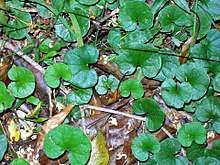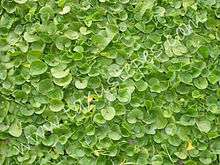Dichondra repens
Dichondra repens is a small, prostrate, herbaceous plant native to New Zealand and many parts of Australia. It is occasionally known as kidney weed in Australia and as Mercury Bay weed in New Zealand. Most commonly called dichondra in Australia.
| Dichondra repens | |
|---|---|
 | |
| At Eastwood, Australia | |
| Scientific classification | |
| Kingdom: | Plantae |
| Clade: | Tracheophytes |
| Clade: | Angiosperms |
| Clade: | Eudicots |
| Clade: | Asterids |
| Order: | Solanales |
| Family: | Convolvulaceae |
| Genus: | Dichondra |
| Species: | D. repens |
| Binomial name | |
| Dichondra repens | |
The plant often occurs in forest, woodland, and grassland habitat types. It can also be found in lawns, where it may be deliberately planted or come up as a weed.[1] In California as well as parts of China it has escaped gardens and naturalised in some habitats.[2][3][4]
Taxonomy
Dichondra repens was originally described by German naturalists Johann Reinhold Forster and Georg Forster, its specific epithet the Latin adjective repens, meaning "creeping".[5] The lectotype was collected by them in New Zealand[6] and is in the Forster collection at Göttingen.[7] In Convolvulaceae, the Morning Glory Family.
Description

The plant is a perennial herb that has a creeping habit, with roots forming at the nodes. The leaves are kidney-shaped to circular and measure 0.5 to 2.5 cm (0.2–1 in) long. The base of the leaf is heart-shaped (cordate) and its apex emarginated or rounded. The upper and undersurface of the leaf are covered in fine hair. The tiny yellowish-green flowers can appear at any time of the year,[8] more profusely from September to February and most so in November.[9] The fruit is a hairy, two-lobed capsule.
Distribution and habitat
Dichondra repens occurs in South Africa.[10] It is found in all mainland Australian states and Tasmania. Within New South Wales it is widespread across eastern and central parts of the state.[8]
It grows on clay or clay-based soils that are medium to high in nutrients in flat places in forested areas. Associated species in New South Wales are river peppermint (Eucalyptus elata), thin-leaved stringybark (E. eugenioides),woollybutt (E. longifolia) and snow-in-summer (Melaleuca linariifolia).[9]
Ecology
The native Pacific black duck (Anas superciliosa) eats the seeds.[9]
Cultivation
This species is cultivated as an ornamental plant, and can be used as a lawn substitute or groundcover in gardens.[11] It comes in shades of green through to grey.
References
- "Dichondra repens (kidney weed)". UC IPM—Weed Gallery. Retrieved 31 January 2013.
- "Dichondra micrantha". Calflora database. Retrieved 31 January 2013.
- "Kidney–weed Dichondra (Dichondra micrantha (=Dichondra repens))". ipm.ucanr.edu. Retrieved 18 May 2019.
- Dawson, Murray (2014). "On distant shores: New Zealand's natives as weeds abroad" (PDF). New Zealand Garden Journal. 17 (1): 10–24.
- Simpson DP (1979). Cassell's Latin Dictionary (5 ed.). London: Cassell Ltd. ISBN 978-0-304-52257-6.
- Nicolson, D.H.; Fosberg, F.R. (2004). The Forsters and the Botany of the Second Cook Expedition (1772 - 1775). Koeltz Botanical Books.
- "Type of Dichondra repens J.R.Forst. & G.Forst". JSTOR. Retrieved 16 October 2018. Cite journal requires
|journal=(help) - Johnson, R.W. "New South Wales Flora Online: Dichondra repens". Royal Botanic Gardens & Domain Trust, Sydney, Australia.
- Benson, Doug; McDougall, Lyn (1995). "Ecology of Sydney Plants 3: families Cabombaceae to Eupomatiaceae" (PDF). Cunninghamia. 4 (2): 217–429 [308]. Archived from the original (PDF) on 13 March 2016. Retrieved 23 December 2016.
- Thiselton-Dyer, William T. (2014). Flora Capensis. Cambridge University Press. p. 83. ISBN 9781108068109.
- "Growing Dichondra repens". GardenWeb. Retrieved 31 January 2013.
External links
| Wikimedia Commons has media related to Dichondra repens. |